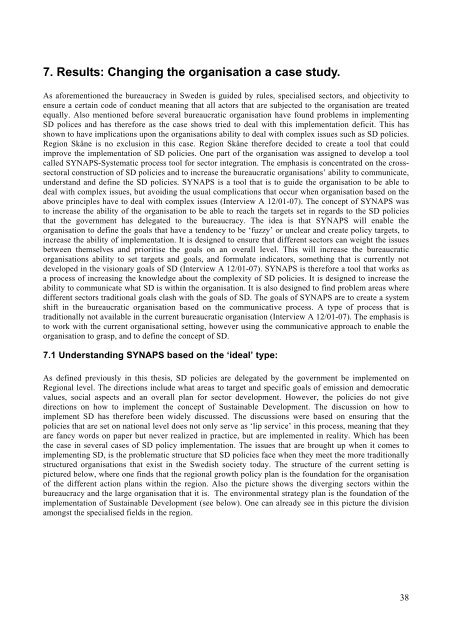From 'grey to green'- investigating the capabilities of the ... - lumes
From 'grey to green'- investigating the capabilities of the ... - lumes
From 'grey to green'- investigating the capabilities of the ... - lumes
Create successful ePaper yourself
Turn your PDF publications into a flip-book with our unique Google optimized e-Paper software.
7. Results: Changing <strong>the</strong> organisation a case study.As aforementioned <strong>the</strong> bureaucracy in Sweden is guided by rules, specialised sec<strong>to</strong>rs, and objectivity <strong>to</strong>ensure a certain code <strong>of</strong> conduct meaning that all ac<strong>to</strong>rs that are subjected <strong>to</strong> <strong>the</strong> organisation are treatedequally. Also mentioned before several bureaucratic organisation have found problems in implementingSD polices and has <strong>the</strong>refore as <strong>the</strong> case shows tried <strong>to</strong> deal with this implementation deficit. This hasshown <strong>to</strong> have implications upon <strong>the</strong> organisations ability <strong>to</strong> deal with complex issues such as SD policies.Region Skåne is no exclusion in this case. Region Skåne <strong>the</strong>refore decided <strong>to</strong> create a <strong>to</strong>ol that couldimprove <strong>the</strong> implementation <strong>of</strong> SD policies. One part <strong>of</strong> <strong>the</strong> organisation was assigned <strong>to</strong> develop a <strong>to</strong>olcalled SYNAPS-Systematic process <strong>to</strong>ol for sec<strong>to</strong>r integration. The emphasis is concentrated on <strong>the</strong> crosssec<strong>to</strong>ralconstruction <strong>of</strong> SD policies and <strong>to</strong> increase <strong>the</strong> bureaucratic organisations’ ability <strong>to</strong> communicate,understand and define <strong>the</strong> SD policies. SYNAPS is a <strong>to</strong>ol that is <strong>to</strong> guide <strong>the</strong> organisation <strong>to</strong> be able <strong>to</strong>deal with complex issues, but avoiding <strong>the</strong> usual complications that occur when organisation based on <strong>the</strong>above principles have <strong>to</strong> deal with complex issues (Interview A 12/01-07). The concept <strong>of</strong> SYNAPS was<strong>to</strong> increase <strong>the</strong> ability <strong>of</strong> <strong>the</strong> organisation <strong>to</strong> be able <strong>to</strong> reach <strong>the</strong> targets set in regards <strong>to</strong> <strong>the</strong> SD policiesthat <strong>the</strong> government has delegated <strong>to</strong> <strong>the</strong> bureaucracy. The idea is that SYNAPS will enable <strong>the</strong>organisation <strong>to</strong> define <strong>the</strong> goals that have a tendency <strong>to</strong> be ‘fuzzy’ or unclear and create policy targets, <strong>to</strong>increase <strong>the</strong> ability <strong>of</strong> implementation. It is designed <strong>to</strong> ensure that different sec<strong>to</strong>rs can weight <strong>the</strong> issuesbetween <strong>the</strong>mselves and prioritise <strong>the</strong> goals on an overall level. This will increase <strong>the</strong> bureaucraticorganisations ability <strong>to</strong> set targets and goals, and formulate indica<strong>to</strong>rs, something that is currently notdeveloped in <strong>the</strong> visionary goals <strong>of</strong> SD (Interview A 12/01-07). SYNAPS is <strong>the</strong>refore a <strong>to</strong>ol that works asa process <strong>of</strong> increasing <strong>the</strong> knowledge about <strong>the</strong> complexity <strong>of</strong> SD policies. It is designed <strong>to</strong> increase <strong>the</strong>ability <strong>to</strong> communicate what SD is within <strong>the</strong> organisation. It is also designed <strong>to</strong> find problem areas wheredifferent sec<strong>to</strong>rs traditional goals clash with <strong>the</strong> goals <strong>of</strong> SD. The goals <strong>of</strong> SYNAPS are <strong>to</strong> create a systemshift in <strong>the</strong> bureaucratic organisation based on <strong>the</strong> communicative process. A type <strong>of</strong> process that istraditionally not available in <strong>the</strong> current bureaucratic organisation (Interview A 12/01-07). The emphasis is<strong>to</strong> work with <strong>the</strong> current organisational setting, however using <strong>the</strong> communicative approach <strong>to</strong> enable <strong>the</strong>organisation <strong>to</strong> grasp, and <strong>to</strong> define <strong>the</strong> concept <strong>of</strong> SD.7.1 Understanding SYNAPS based on <strong>the</strong> ‘ideal’ type:As defined previously in this <strong>the</strong>sis, SD policies are delegated by <strong>the</strong> government be implemented onRegional level. The directions include what areas <strong>to</strong> target and specific goals <strong>of</strong> emission and democraticvalues, social aspects and an overall plan for sec<strong>to</strong>r development. However, <strong>the</strong> policies do not givedirections on how <strong>to</strong> implement <strong>the</strong> concept <strong>of</strong> Sustainable Development. The discussion on how <strong>to</strong>implement SD has <strong>the</strong>refore been widely discussed. The discussions were based on ensuring that <strong>the</strong>policies that are set on national level does not only serve as ‘lip service’ in this process, meaning that <strong>the</strong>yare fancy words on paper but never realized in practice, but are implemented in reality. Which has been<strong>the</strong> case in several cases <strong>of</strong> SD policy implementation. The issues that are brought up when it comes <strong>to</strong>implementing SD, is <strong>the</strong> problematic structure that SD policies face when <strong>the</strong>y meet <strong>the</strong> more traditionallystructured organisations that exist in <strong>the</strong> Swedish society <strong>to</strong>day. The structure <strong>of</strong> <strong>the</strong> current setting ispictured below, where one finds that <strong>the</strong> regional growth policy plan is <strong>the</strong> foundation for <strong>the</strong> organisation<strong>of</strong> <strong>the</strong> different action plans within <strong>the</strong> region. Also <strong>the</strong> picture shows <strong>the</strong> diverging sec<strong>to</strong>rs within <strong>the</strong>bureaucracy and <strong>the</strong> large organisation that it is. The environmental strategy plan is <strong>the</strong> foundation <strong>of</strong> <strong>the</strong>implementation <strong>of</strong> Sustainable Development (see below). One can already see in this picture <strong>the</strong> divisionamongst <strong>the</strong> specialised fields in <strong>the</strong> region.38
















